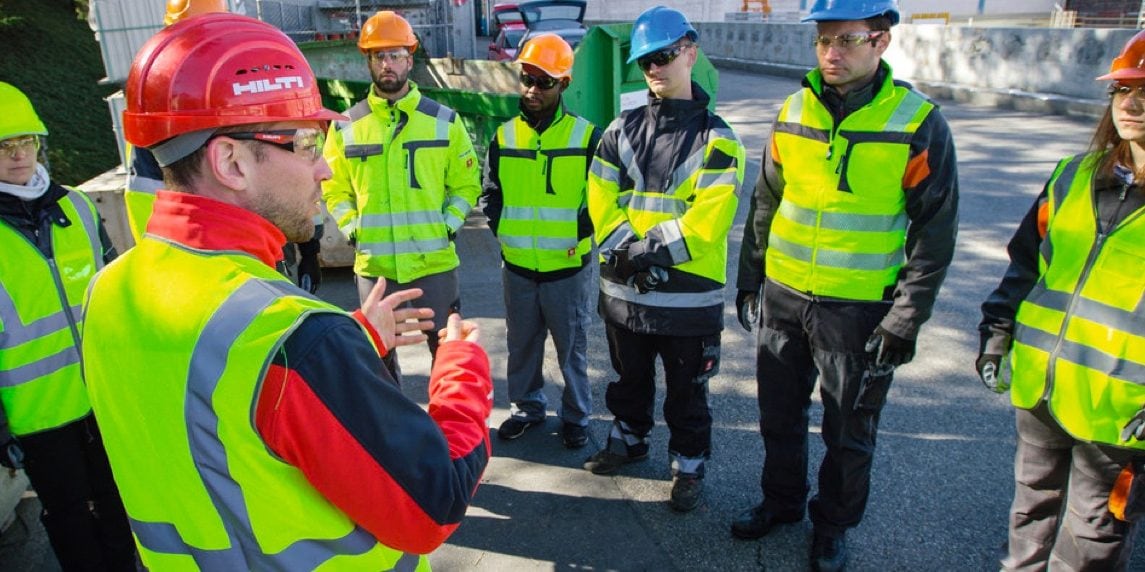- Home
- Solutions
- News and Events
- Hilti Blog
- 5 ways to reduce jobsite accidents
5 ways to reduce jobsite accidents

Every year, workers on construction sites in Europe suffer from injuries, poor health and fatal accidents - with the construction industry as a whole being responsible for 20% of all fatal accidents at work across Europe. According to the HSE, an estimated 555,000 workers sustained non-fatal injuries in the UK alone throughout 2017 and 2018.
The statistics are damning and, while it’s impossible to stop site accidents altogether, it is possible to reduce the risk of them happening - which in turn can improve jobsite productivity. You can do this by understanding the root causes of common health and safety issues, then putting practical and effective measures in place to properly manage risks and keep your employees safe.
Here are 5 ways to reduce jobsite accidents:
1. Use tools with the latest safety technology
Selecting safe tools (that are appropriate for the job at hand) and maintaining them well is one of the easiest ways to reduce accidents on-site. Not only is there less chance of injury, but consistently safe tools also improve productivity, as workers won't have to worry about using faulty or dangerous equipment.
A common injury across the sector is Hand-Arm Vibration Syndrome (HAVS), which occurs when employees are exposed to high levels of vibration - usually from using powerful hand tools over a prolonged period of time. It may seem logical to assume that the best tool to avoid HAVS would have the lowest vibration value, but this isn't the case.
When tool performance is taken into account, workers can often experience less vibration using a tool with a higher vibration value, as the job will be completed quicker. So, the safest tool isn’t always the most obvious one. This is just one example of how carefully selecting safe tools can not only reduce the risk of accidents, but can also improve productivity.
However, curating a selection of safe tools isn’t enough - they must be maintained to an excellent standard too. This can be done by investing in a digitised asset management system that keeps track of tools, so that certifications are up-to-date and both the tool and the person using it can be tracked in case accidents occur.
If a tool does break, it's a good idea to keep spares as a back-up, as well as ensuring the broken tool is fixed quickly with effective fleet management.
By doing this, you'll not only raise employee satisfaction through workers that feel safe and valued, but reduce the risk of accidents significantly.
2. Keep jobsites clean & tidy
According to HSE figures, slips, trips and falls accounted for 31% of non-fatal injuries on site in 2017/18. While slips and trips are sometimes an inevitability - even on the cleanest of sites - they can be somewhat prevented and reduced by putting safety procedures in place to keep all loose cables, cords and debris out of the working area. Although this may seem time-consuming, it's worth it to prevent nasty injuries.
Another common but underestimated problem within the construction industry is dust inhalation, caused by intrusive jobs like drilling, breaking, slitting, sanding and sawing. Essentially, any grinding in which the dust inhaled can cause respiratory illnesses or cancer (often many years after the initial exposure).
Whilst you can’t force workers to wear masks, you can safely remove most of the harmful dust and debris using a vacuum and on-tool dust extraction systems. This will not only save time spent sweeping and ensuring the area is clean, but it'll also minimise the risk of dust inhalation.
3. Provide health & safety training
Preventing injuries on-site requires more than just good housekeeping - it requires employees to be constantly aware of the dangers around them. As an employer, you must go above and beyond obligation (basic regulations and requirements) to provide workers with the health and safety knowledge they need to feel comfortable and valued on-site.
It's important for workers to be expertly trained on planned emergency procedures, as well as general on-site precautions. A good way to do this is with the STOP! Principle, which provides practical strategies to reduce the impact of things like dust, vibration and kickback. This is a simple and effective way to implement proper health and safety training, that employees will be able to remember and use if a situation arises.
Problems arise when safety isn’t regularly communicated to workers, so make sure you're always keeping them in the loop.
4. Ensure certificates are up-to-date & regulations are followed
Of course, where possible, avoid working at height completely. But when this is unavoidable - as it often is - employers must adhere to a number of work at height regulations.
These usually state that employers must provide lifting equipment that is fit for purpose, appropriate for the task, suitably marked and, where appropriate, subject to statutory thorough examination. They will normally also state that lifting operations must be properly planned and supervised.
This can become tricky if the correct systems aren't in place to ensure these regulations are being followed, and that all certifications are up to date. It would be highly beneficial to use management software for this, so any lifting equipment information is easily accessible and easy to update if needed. As accidents at height are often very serious or fatal, this is one of the best things you can do to prevent incidents from happening.
5. Go cordless
Using cordless tools is an easy way to reduce jobsite accidents, as there's no cable for workers to trip or slip on. They also increase productivity and mobility, as workers are less likely to injure themselves trying to perform tasks that are made more difficult with cords.
By putting these 5 steps in place, it'll be easier to anticipate potential dangers and act with caution, rather than reacting after an incident has occured. Having the right tools, plans and systems is the first step towards risk prevention.
For more info on how to optimise your health and safety strategy, download our free Construction Site Safety Guide below. You'll find in-depth descriptions about must-know regulations, learn how to successfully implement health and safety measures on-site, and how to ensure your business is fully compliant.

